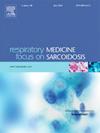揭示肺动脉高压的代谢挑战:洞察甲状腺、血糖、血脂和骨骼疾病。
IF 3.5
3区 医学
Q2 CARDIAC & CARDIOVASCULAR SYSTEMS
引用次数: 0
摘要
本研究旨在评估成年肺动脉高压(PAH)患者中甲状腺、血糖、血脂和骨代谢紊乱的患病率:这是一项观察性横断面临床研究,研究对象为肺动脉高压患者,按性别和年龄与未患肺动脉高压的对照组相匹配。所有患者都接受了临床评估、代谢检查、甲状腺超声波检查和骨密度测量:PAH 组有 35 人(34 名女性,46 ± 15.5 岁),对照组有 40 人(39 名女性,41.8 ± 13.1 岁)。PAH 组和对照组的体重指数(BMI)(分别为 27.5 ± 5.9 和 26.9 ± 4.3 kg/m2;P = 0.63;95% CI = -1.8, 2.94)和每周体育锻炼时间(分别为 60.3 ± 103.3 和 98.9 ± 137.6;P = 0.17;95% CI = -95.23, 18.06)均无差异。虽然 PAH 组(51.4%)和对照组(47.5%)的胰岛素抵抗发生率没有差异(P=0.74),但 PAH 患者的糖化血红蛋白(A1c)中位数高于对照组(分别为 6.1% 和 5.57%),P=0.006;95% CI = -0.14, 1.22。PAH 组的总胆固醇平均值(170.46 ± 35.51 mg/dL)和低密度脂蛋白胆固醇中位数[105 (46) mg/dL,中位数(四分位距)]水平低于对照组[分别为 192.1 ± 34.44 mg/dL,p=0.009;95% CI = -37.76,5.52;121.6 (35.02) mg/dL,p=0.012;95% CI = -34.08,0.77]。研究发现,PAH 组甲状腺功能减退症的发病率(22.9%)高于对照组(2.5%),P=0.007。我们在 PAH 组的 8 名患者(23%)中发现了甲状旁腺功能亢进症(HPT),而在对照组中却没有发现。在骨矿物质密度紊乱方面,PAH 组有 12 名患者出现低骨量、骨质疏松或骨质疏松症(34%),对照组有 8 人(20%),P =0.032,前者出现这些症状的相对风险比后者高 2.13。HPT患者的肌酐水平(0.98 ± 0.12 mg/dL)高于甲状旁腺激素正常的PAH患者(0.76 ± 0.14 mg/dL),P = 0.0004; 95% CI = 0.12, 0.33。PAH组的总髋关节(-0.15 ± 1.25)和股骨颈(-0.14 ± 1.07)骨质密度(BMD)Z值也低于对照组(分别为0.50 ± 1.13,p = 0.021;95% CI = -0.18,-0.027;0.35 ± 0.94,p = 0.038;95% CI = -0.16,-0.01):在该队列中,与对照组相比,PAH 组的 A1c 水平更高、甲状腺功能减退症患病率更高、低密度脂蛋白和总胆固醇水平更低、甲状旁腺功能亢进症患病率更高,以及总髋关节和股骨颈 BMD Z 值更低,这些发现突显了 HAP 患者体内各种代谢途径的失调,表明有必要采取有针对性的干预措施来加强对患者的护理。此外,他们还强调了深入了解这些变化的驱动机制及其与疾病的潜在病理生理联系的重要性。本文章由计算机程序翻译,如有差异,请以英文原文为准。
Unveiling the metabolic challenges in pulmonary arterial hypertension: Insights into thyroid, glycemic, lipid, and bone disorders
This study aimed to evaluate the prevalence of thyroid, glycemic, lipid and metabolic bone disorders among adult patients with pulmonary arterial hypertension (PAH).
Methods
This was an observational cross-sectional clinical study with patients with PAH, matched by sex and age with a control group without PAH. All individuals were enrolled into a clinical assessment, metabolic workup, thyroid ultrasound, and bone densitometry protocol.
Results
The PAH group included 35 participants (34 females, 46 ± 15.5 years), and the control group, 40 (39 females, 41.8 ± 13.1 years). There was no difference in body mass index (BMI) between PAH and control group (27.5 ± 5.9 and 26.9 ± 4.3 kg/m2, respectively, p = 0.63; 95 % CI: −1.8, 2.94), neither in physical activity time per week (60.3 ± 103.3 and 98.9 ± 137.6, respectively, p = 0.17; 95 % CI: −95.23, 18.06). Although there was no difference in the prevalence of insulin resistance between the PAH (51.4 %) and the control group (47.5 %), p = 0.74, patients with PAH had a higher median of glycated hemoglobin (A1c) than the control group (6.1 % and 5.57 %, respectively, p = 0.006; 95 % CI: −0.14, 1.22). PAH group presented lower mean total cholesterol (170.46 ± 35.51 mg/dL) and median LDL-cholesterol [105 (83–129) mg/dL, median (P25–P75)] levels than the control group [192.1 ± 34.44 mg/dL, p = 0.009; 95 % CI = −37.76, 5.52 and 121.6 (97–145) mg/dL, p = 0.012; 95 % CI: −34.08, 0.77, respectively]. It was found a higher prevalence of hypothyroidism (22.9 %) in PAH group than in control group (2.5 %), p = 0.007. We found hyperparathyroidism (HPT) among 8 patients of PAH group (23 %), but none in the control group. Considering bone mineral density disorders, 12 patients from PAH group presented low bone mass, osteopenia, or osteoporosis (34 %), and 8 individuals in the control group (20 %), p = 0.032, which represented a 2.13 higher relative risk for those conditions for the former group. The patients with HPT presented a higher creatinine level (0.98 ± 0.12 mg/dL) than the PAH patients with normal parathyroid hormone (0.76 ± 0.14 mg/dL), p = 0.0004; 95 % CI: 0.12, 0.33. The PAH group also presented lower total hip (-0.15 ± 1.25) and femoral neck (−0.14 ± 1.07) bone mineral density (BMD) Z-scores than the control group (0.50 ± 1.13, p = 0.021; 95 % CI: −0.18, −0.027 and 0.35 ± 0.94, p = 0.038; 95 % CI: −0.16, −0.01, respectively).
Conclusion
In this cohort, the findings of higher A1c levels, hypothyroidism prevalence, lower LDL and total cholesterol levels, and a higher prevalence of hyperparathyroidism, as well as lower total hip and femoral neck BMD Z-scores in the PAH group, compared to the control group and highlighting the dysregulation of various metabolic pathways in patients with HAP, suggesting the need for targeted interventions to enhance patient care. Additionally, they underscore the importance of gaining a deeper understanding of the mechanisms driving these changes and their potential pathophysiological connections to the disease.
求助全文
通过发布文献求助,成功后即可免费获取论文全文。
去求助
来源期刊

Respiratory medicine
医学-呼吸系统
CiteScore
7.50
自引率
0.00%
发文量
199
审稿时长
38 days
期刊介绍:
Respiratory Medicine is an internationally-renowned journal devoted to the rapid publication of clinically-relevant respiratory medicine research. It combines cutting-edge original research with state-of-the-art reviews dealing with all aspects of respiratory diseases and therapeutic interventions. Topics include adult and paediatric medicine, epidemiology, immunology and cell biology, physiology, occupational disorders, and the role of allergens and pollutants.
Respiratory Medicine is increasingly the journal of choice for publication of phased trial work, commenting on effectiveness, dosage and methods of action.
 求助内容:
求助内容: 应助结果提醒方式:
应助结果提醒方式:


